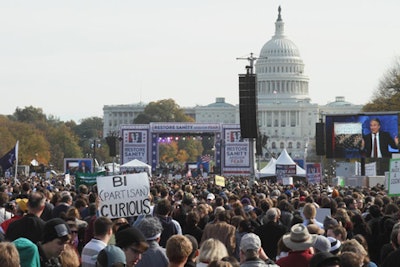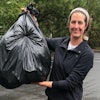
There's no question the use of social media is a popular topic of discussion in the event and meeting community, and Social Media Week was a hotbed of information for marketers. Among the sessions that took place February 7 through 11, the panel discussion that went behind the scenes of Jon Stewart and Stephen Colbert's Rally to Restore Sanity and/or Fear yielded some interesting insights into the practical application of the new technology at live events.
With Craig Minassian, president of Minassian Media and the rally's producer, acting as moderator, Comedy Central Digital senior vice president Steve Grimes and MTV Networks Entertainment vice president of digital marketing Don Steele presented a look into how, through Facebook, Flickr, Twitter, and other platforms, the public gathering from the late-night TV show hosts became one of the most-talked-about events in Washington last year.
At the Tuesday afternoon discussion in the Hearst Tower, Grimes, Steele, and Minassian recounted the situation they faced when planning the October 30 event on the National Mall. The team had little more than six weeks to organize a constantly evolving concept, and no allocated marketing budget. (In fact, Comedy Central was already in the midst of organizing an event, the Stewart-hosted "Night of Too Many Stars" benefit concert held October 2 at the Beacon Theatre.) "If you're fans of The Daily Show, you know that this was launched on September 16 on the show. There were two competing rallies, and people weren't sure what to make of it, including all of us who were asked to produce," explained Minassian.
Focused on attracting people to the event, Grimes and Steele relied heavily on social media to disseminate information and track the numbers planning to attend. The virtual efforts paid off: The rally was the largest single event on Foursquare at the time, more than 250,000 people turned out on the mall, more than two million watched the live TV broadcast, and there were about 570,000 views of the online live stream—the largest ever such online viewership for MTV Networks.
In addition to sharing the experience of planning, producing, and marketing the unprecedented undertaking, the panelists also provided some helpful advice on how to boost attendance and engagement. Here's what they suggested:
Strategies can be reactive as well as proactive.
"A lot of digital marketing now is reacting to the demand of the audience," said Steele, adding that in the month leading up to the rally, fans took to multiple sites and "whatever people wanted to know about, we had to supply it and meet demand." The corporate marketer reasoned that event and meeting organizers should look outside the channels normally used by their attendees. "People are going to use a lot of different things to figure [an event] out for themselves. So if you're not thinking of what it's going to look like on Flickr, if there's a Meetup opportunity, if people are talking about it on Twitter, or if there's a Facebook event, [you could miss an opportunity]."
"A lot of it is telling people what to do, but in this case, the fans were telling us what they wanted to do; and if we didn't do it with them and for them, it wouldn't have been a fun experience," explained Steele of his decision to integrate a wide array of social media sites into the marketing tactics for the rally.
Partnerships can lighten the load.
Indeed, when the team saw a large number of potential rally attendees interacting on Meetup, they decided to collaborate with the networking site. The planners also reached out to Foursquare, Flickr, Facebook, and others. "Don't try to do it all yourself. Find strategic partners to fill the gaps and take as much off your plate as you can," advised Grimes.
"We knew people were going to be taking pictures and knew we wanted to have a way for them to share their pictures with their friends and with us. So who do we call? We call Flickr. We knew there would be a Facebook R.S.V.P., so it was calling Facebook and asking, 'What are the best practices for doing something like this?'" said Steele. "It was calling Foursquare and telling them what's going to happen and letting them in on it."
Online tools help disseminate real-time information.
The virtual conversation and coverage from media outlets and blogs helped build the momentum for the rallies, but it also raised fears of overcrowding and limited access to parking, bathrooms, and other amenities. So Steele used the event's social media network to inform the crowds, as well as promote the event.
"If you watched the news reports around that time, they emphasized things like 'Get to the train early,' 'It'll be crowded,' and 'There won't be parking in the city.' And from an event organizer's point of view, that can really scare people off," said Minassian. "One of the things [the marketing team] did that was really helpful was constantly provide real information to attendees, saying 'Here's how you get there,' 'Here's where you park,' 'If you're looking for T-shirts, here's where they are.'"
Social media shouldn't be an afterthought.
Most significantly, the success of the rallies has influenced the network's marketing efforts. "In the time I've been at Comedy Central—seven months now—the tenor of the conversation has changed. From social media being a nice-to-have, quirky thing that you add on to your marketing plan to the number one bullet point as we're planning new shows," said Grimes. Grimes explained that since the rally, the television and digital ratings for both shows have continued to rise, a growth he attributes to the foundation in social media they built around the rally. "In the earliest meetings [for the rally], Stephen recognized that this was an opportunity for the shows to get more engaged. Both the shows are now far more actively engaged in Twitter than they were six to 12 months ago, and they've recognized the power of this."
Comedy Central also plans to use Twitter for the upcoming roast of Donald Trump, inviting the audience to come up with their own quips before the show, comments that will be shared through a designated hashtag. However, the microblogging site is not the only tool the network is using to build interaction with fans of shows. "We're not looking at any one platform. It's making sure we're having the same brainstorming sessions that we had at the start of the rally and asking ourselves, 'What are all the rocks we can look under?'" It's having that conversation for every show before it goes into production, so that we're not retroactively approaching social media," added Grimes.



















